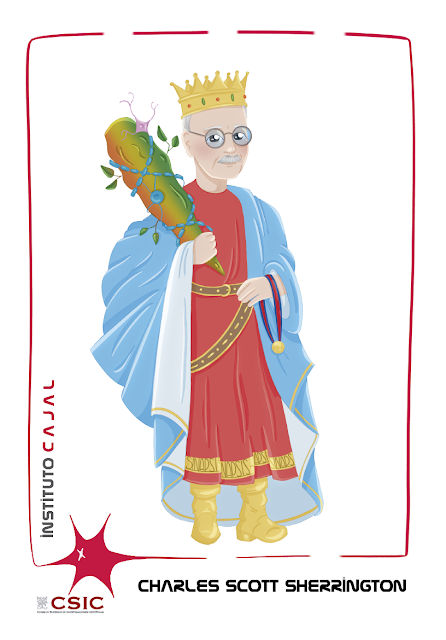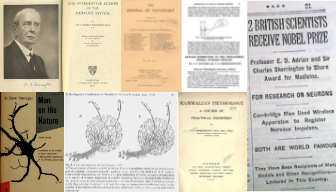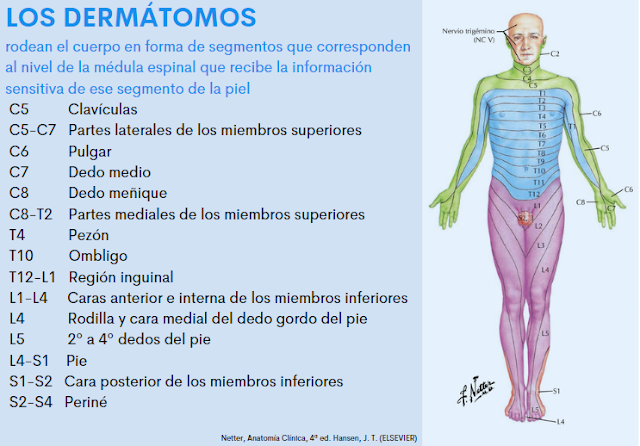KING OF WANDS
CHARLES SCOTT SHERRINGTON
King of Wands: CHARLES SCOTT SHERRINGTON (1857 – 1952), British “el Cajal” who gave his name to synapses and described the integrated action of the nervous system

Cajal and Sherrington were parallel geniuses trapped by the luxuriance of a nervous tissue that they tirelessly observed: the first to describe the neuronal “branches of the forest” and the second to understand the paths of the circulating “nervous sap.” Form and structure. Patience and imagination. The synapse was their meeting point to go down in the history of neuroscience.
Despite being born in two countries separated by an arm of the Atlantic, it is curious to see the number of similarities that bring together the great native Cajal and the British Sherrington: starting with their coincidence in time – halfway between the 19th and 20th centuries – and continuing for his key contributions to modern neuroscience.
They were both awarded a shared Nobel Prize: Cajal with Golgi in 1906 “in recognition of their work on the structure of the nervous system” and Sherrington with Adrian in 1932 “for their discoveries relating to the function of neurons.” Between the two of them they managed to turn the “impenetrable forest” of nervous tissue into an “organized and delicious garden” [1].

Sherrington’s work was supported by Cajal’s and was fundamental in confirming the neuronal theory proposed by the Spanish scientist [3]. Both Cajal—from the structure—and Sherrington—from the function—provided complementary evidence for the existence of individual entities called neurons, connected thanks to the synapse. Douglas and Martin [2] draw an interesting parallel between the structure and function of the brain and the scientific links of Cajal and Sherrington, which they say “were found at the synapse”, although it was Sherrington who, in 1897, coined this term to name the “kiss” between neurons described by Cajal.
While for Sherrington the neuron was the functional unit that integrated excitatory and inhibitory impulses, for Cajal the synapse individualized the neurons in the circuits. The genius of both was being able to extrapolate their descriptions of local circuits to higher cognitive functions, all with a poetic language that enriches 21st century neuroscience with foundational concepts [2]. As Dr. José Ramón Alonso summarizes, “if Cajal had explained what the nervous system was like, Sherrington was unraveling how it worked.”
Sherrington began by investigating which muscles each ventral root of the spinal nerves controlled and, conversely, which part of the skin generated electrical activity back to the spinal cord through the dorsal root. He thus constructed segmented maps of the skin called dermatomes and observed that those for pain and heat were smaller than those for touch. This helped him formulate his [Sherrington’s] first law: each posterior root of a spinal nerve receives information from a specific area of the skin, with some overlap between adjacent dermatomes [1] [8]. While studying sensory nerves and muscles, Sherrington also laid the foundation for what has since been called the proprioceptive system [6].

During his time at the University of Liverpool, Sherrington worked on the connections between the brain and spinal cord, where he observed that reflexes were integrated activities of the entire organism and not just the result of the small circuit of the reflex arc [1]. His work in this field culminated in 1906, the year in which Sherrington marked the history of neurophysiology with the publication of his book Integrative Action of the Nervous System—the same year, incidentally, that he was awarded the Nobel Prize to Cajal and Golgi—where he explained that the behavior of an organism is the final result of a nervous integration process. In its most basic form, this means that a neuron where multiple excitatory and inhibitory endings converge is capable of producing a new output signal destined for the neurons of one or several integrating structures where, in turn, this same operation will be repeated [4]. [9].
“In fact, it was the clarity of his functional thinking in terms of neurons and the synaptic relationships between them that differentiated Sherrington from other neurophysiologists of his time.” J.E. Eccles, 1957 [10]
In addition to being one of the founders of the British neurophysiological school, Sherrington made very important contributions, for which he earned the Nobel Prize in Physiology or Medicine in 1932 along with Edgar Douglas Adrian and which, summarized, are as follows [1][2] [5][7][9]:
He postulated the synaptic hypothesis: information travels from one neuron to another through a very small interval between both nerve cells, which he called synapse (1897).
He made important discoveries about the reflex functions of the spinal cord:
He observed that the reflex arc circuit is activated in response to a stimulus from the external environment.
He demonstrated that central inhibition is an active phenomenon and formulated the common pathway principle (Silliman Lectures of 1904 at Yale University) to refer to the coordination of nervous functions, with the brain as the governing and initiative organ. conduct and behavior of the living being as a whole.
He stated two laws:
SHERRINGTON’S FIRST LAW: Each posterior root of a spinal nerve receives information from a specific area of skin (dermatome), with some overlap between adjacent areas
SHERRINGTON’S SECOND LAW OF RECIPROCAL INNERVATION: a muscle receives a nervous impulse to contract and its opposite simultaneously receives another to relax.
He laid the foundations of what was later called the proprioceptive system, distinguishing three types of receptors: extero-, intero- and proprioceptive:
He studied proprioceptive reflexes in decerebrate animals and mapped their circuits in the spinal cord (Decerebrate Rigidity and Reflex Coordination of Movements, published in 1898).
Despite the limitations of Sherrington’s conclusions in reflex theory, many of his assumptions about how the central nervous system controls movement have been reinforced and continue to be considered in current medical practices.
We cannot forget the literary side of Sherrington, who in 1925 published some sensitive and delicate verses under the title The Assaying of Brabantius and other Verse. His taste for music and prose, combined with his biological and philosophical knowledge, were also evident in the Rede Lecture that he gave in Cambridge in 1933 with the title The Brain and its Mechanism. Like his teacher and friend Cajal, Sherrington also published a work of reflection: Man on his Nature (and its follow-up volume The Endeavor of Jean Fernel, published in 1946) where through his analysis of the thought of the French Renaissance physician Jean Fernel, offers his answer to philosophical questions.
“He was a true liberal, scientist, poet and philosopher […], an eminence not only for his work, but for the place he occupies in the esteem of each of his companions.” E.D. Adrian, 1952 [9]
Surely this entry has shown you many of the synapses that existed between Cajal and Sherrington, two great neuroscientists whose complementary work laid the foundations of modern neuroscience at the beginning of the 20th century. You can continue learning with this interactive infographic:
Have you been curious and want to know more?
NOTES AND SOURCES CITED
[1] In 1894 Cajal, who was relatively young and very little known, was invited by the Royal Society to give the Croonian Lecture, one of the main lectures of the year. Cajal gave the talk in French and titled it La fine structure des centers nerveux. Sherrington put him up in his house. Sir Charles told years later how Cajal managed to stimulate all the young English researchers interested in the brain. At the banquet in his honor, Michael Foster, Sherrington’s boss, made a toast saying that thanks to Cajal’s work “the impenetrable forest of nervous tissue has become an organized and delicious garden” and that the Aragonese savant “had achieved establish recurring collaterals and motor plates between the souls of Spain and England, until then separated by centuries of misunderstanding and indifference.
Extracted from Neurociencia, the blog of neurobiologist and scientific communicator José Ramón Alonso, entry Sherrington https://jralonso.es/2014/12/20/sherrington/
[2] DOUGLAS, Rodney & MARTIN, Kevan (2007). The butterfly and the loom. Brain research reviews. 55. 314-28. https://doi.org/10.1016/j.brainresrev.2007.04.011
[3] CAVADA, Carmen. Historical introduction to neuroscience https://www.senc.es/wp-content/uploads/2017/11/Historia_de_La_Neurociencia_CC.pdf
EU – Encyclopaedia Universalis France:
[4] GALIFRET, Y. et LAPORTE, Y. Charles Sherrington : concept d’intégration nerveuse https://www.universalis.fr/encyclopedie/charles-sherrington-concept-d-integration-nerveuse/
[5] BROSSOLLET, J. Sherrington, Sir Charles Scott https://www.universalis.fr/encyclopedie/sherrington-sir-charles-scott/
[6] The term proprioception derives from the Latin, proprius (“belonging to oneself”), and ception (“perceive”). It was introduced in 1906 by Nobel Prize winner Sir Charles Scott Sherrington, to refer to the sensations originating in deep areas of the human body. Proprioception is one of the most important somatic senses. The somatic senses are functions of the nervous system that collect sensory information, but are not any of the special senses (sight, hearing, taste, touch, smell, and vestibular sense). Three somatic senses have classically been described: pain, the thermoreceptor sense, and the mechanoreceptor sense. Proprioception is included in the third of the somatic senses, and encompasses position sensation and neuromuscular control of the joints. The components of our joints (muscles, tendons and ligaments) along with vision and balance constantly send information to the brain about their position with respect to our environment, forming an image or pattern of each other’s location and state. This information is what allows our brain to manufacture responses, resulting in the execution of precise movements.
Taken from:
https://www.elsevier.es/es-revista-revista-iberoamericana-cirugia-mano-134-articulo-el-papel-propiocepcion-el-control-S1698839615000134
and from https://www.fisioterapia-online.com/articulos/que-es-la-propiocepcion-como-Function-y-cual-es-su-importancia-en-fisioterapia
[7] GRANT, Gunnar (2006) The 1932 and 1944 Nobel Prizes in Physiology or Medicine: Rewards for Ground-Breaking Studies in Neurophysiology, Journal of the History of the Neurosciences: Basic and Clinical Perspectives, 15:4, 341-357 http ://dx.doi.org/10.1080/09647040600638981
[8] FRESQUET FEBRER, José Luis (2006). John Newport Langley. historiadelamedicina.org https://www.historiadelamedicina.org/pdfs/langley.pdf
[9] ADRIAN ED. (1952). Charles Scott Sherrington, O.M., G.B.E., F.R.S. J Physiol. 1952 Oct;118(2):145-8. https://physoc.onlinelibrary.wiley.com/doi/epdf/10.1113/jphysiol.1952.sp004781
[10] BURKE, Robert E. (2007). Sir Charles Sherrington’s The integrative action of the nervous system: a centenary appreciation, Brain, Volume 130, Issue 4, April 2007, Pages 887–894, https://academic.oup.com/brain/article/130/4/887 /278000
BIOGRAPHIES
GIBSON, W.C. (2001) Sir Charles Sherrington O.M., P.R.S. (1857-1952). Twentieth Century Neurology. The British Contribution. Imperial College Press, Chapter I: 1-7. https://web.archive.org/web/20090326160135/http://www.worldscibooks.com/medsci/etextbook/p210/p210_chap1.pdf
FRESQUET FEBRER, José Luis (2002). Charles Scott Sherrington (1857-1952)
https://www.historiadelamedicina.org/sherrington.html
https://www.biografiasyvidas.com/biografia/s/sherrington.htm
https://www.nobelprize.org/prizes/medicine/1932/sherrington/biographical/
